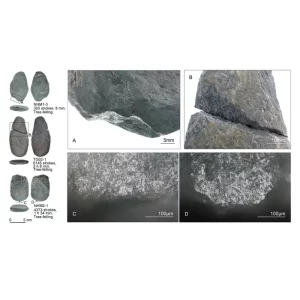Scientists Play With Stone-Age Tools
My marketing experience makes me think there’s a considerable non-science application for this. Picture employee team-building exercises that involve making Stone Age tools and then having a chance to use them. But I digress.
A research team from Tokyo Metropolitan University constructed replica Stone Age tools and used them for various tasks to see which activities left which traces on the edges of the tools. These macroscopic and microscopic traces can tell us how the stone edges were once used. For example, dated stone edges with indications of being used on wood would help to identify when humans began to use timber.

Credit: Tokyo Metropolitan University
Paleolithic (early Stone Age) artifacts indicate the use of wood for simple tools such as spears or throwing sticks. By the Mesolithic and Neolithic periods, artifacts were more sophisticated and used to build houses, canoes, bows, and wells. This shows the availability of tools that enabled more complex wooden instruments, particularly polished stone axes. Approximately 10,000 years ago, ground stone axes were found from periods significantly before this. Scientists have recovered many ground-edge artifacts from 60,000 to 30,000 years ago in sites around Australia and Japan. What was their use?
The scientists tried to establish what kinds of activities left types of traces on ground-stone edges. They crafted replicas of tools that could have been used 38,000 – 30,000 years ago. They crafted and polished the edges using knapping and grinding techniques and adopted methods to attach handles to the stone edges to create adzes, axes, and chisels.
The team used the tools for 15 activities, including tree-felling, hide-processing, and butchering. Then, they looked at the tools’ edges for both macroscopic and microscopic traces of their use. Impacts such as those required for cutting down trees leave distinctive, macroscopic fractures on the stone; friction at the micron-scale between the stone edge and wood also forms microscopic traces that researchers can use for diagnosis. The combination of both macroscopic and microscopic evidence enables conclusions as to tool use.
The team believes that if similar traces are found on the edges of actual artifacts, humans honed woodworking technology significantly earlier than currently thought. This would change our understanding of stone tools used by Ice Age humans and how such technology spread to different environments.

